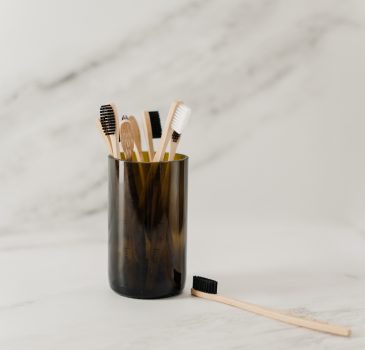Breaking the Plastic Habit
Over the past several weeks as I’ve tried to break my plastic habit, I’ve discovered that the most effective approach is a change of mind. I am thinking more holistically about the products I buy, looking for plastic alternatives, thinking about where plastics will go when I’m done with them, and considering things I could do differently in my daily living.
Given that plastic really began to proliferate 50-60 years ago, I’ve found it helpful to think back to life when I was a child. (This is one time when it really is good to be somewhat dated!)
In the kitchen, we relied on wax paper, Mason jars, and Pyrex containers to store food. Mom froze cookies in metal coffee cans. Tomato juice was marketed in a can. On the rare occasions we enjoyed soda, it came in a heavy glass bottle that went back to the producer to be used again and again.
In the laundry room, whites were washed in hot, hot water—a practice we now realize creates a weighty carbon footprint— but clothes were dried by the sun. No electricity required.
Bumpers on cars were metal back then, hairbrushes boasted natural bristles, and clothes tended to be constructed from organic fibers such as cotton, wool, or linen. Those ugly polyester bell bottoms didn’t appear until the 70s. Were we aware then that polyester, acrylic, and nylon were made from fossil fuels? I don’t think so. We just loved that they didn’t need to be ironed. And those bumpers. You could actually bump them without totaling the car.
At the grocery store, what we now call “convenience foods” were few and far between. We shredded lettuce from a head, ate vegetables preserved in cans (overcooked already and bland despite all the added salt), we sliced mushrooms purchased in bulk—not encased in a plastic bag or tub, and we never saw individual cucumbers wrapped in plastic. Really! Isn’t that overkill?
I’ve been trying to recollect our way of living decades ago, not to recapture it indiscriminately, but to discern what choices I could make to live with less plastic today.
On my journey, I’ve discovered lots of people doing the same thing. Shirley Hoffmann recommends biodegradable bamboo toothbrushes. Tira Nesset uses shampoo and conditioner bar soaps to eliminate plastic bottles. Sylvia Lei does her laundry with soap nuts. You’ve read recently how Lisa Staul manages the purchase and storage of her fruits and vegetables.
The good news is that we can make choices that are better for the environment. I see hope in what individual families are doing. And I’m encouraged by the many, many companies I’ve discovered that are committed to limiting their use of plastic and working to improve the environment for all of us in other ways, too.
– Carol Harker (Community Carbon Team Member at St. Andrew Lutheran Church)

